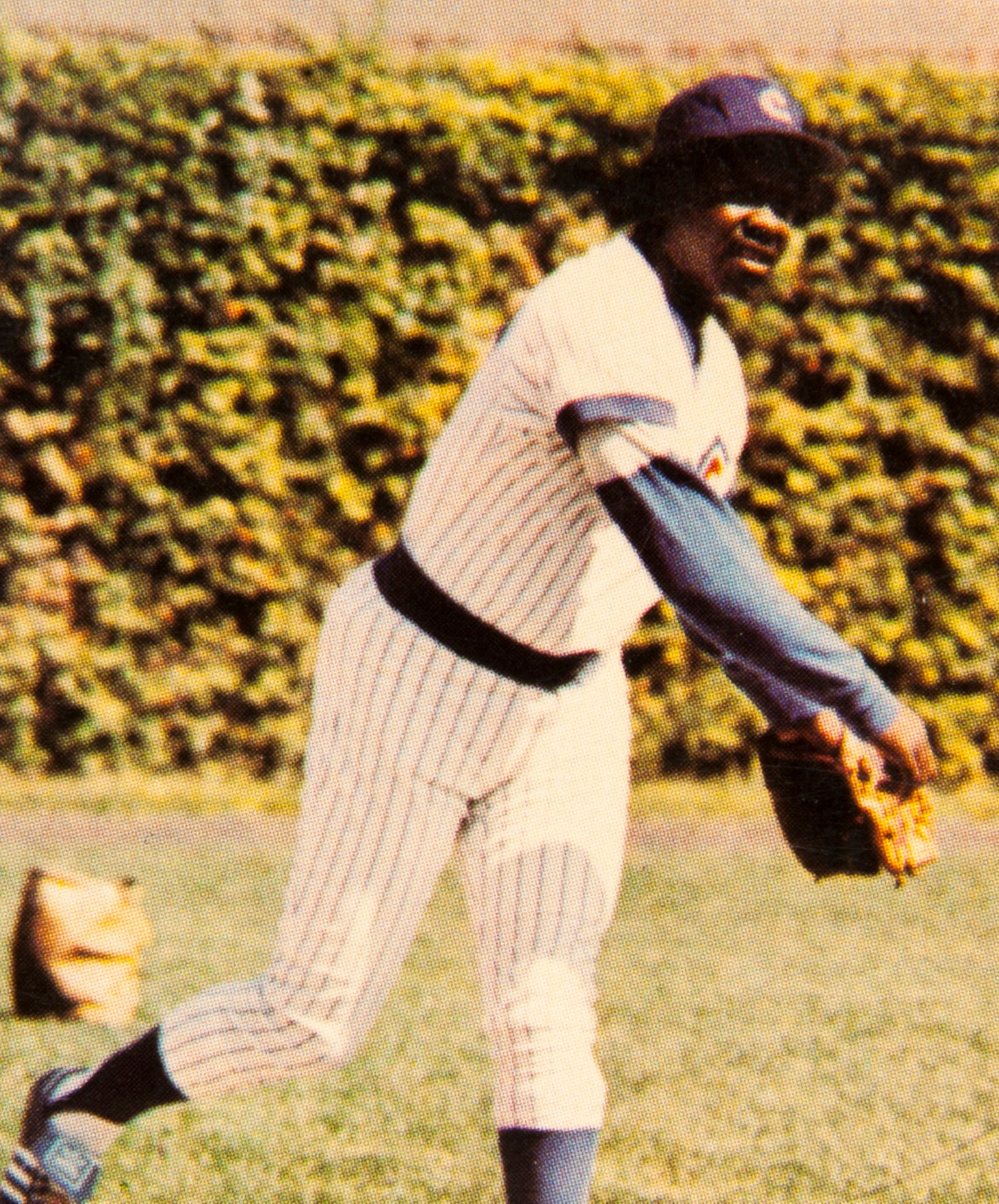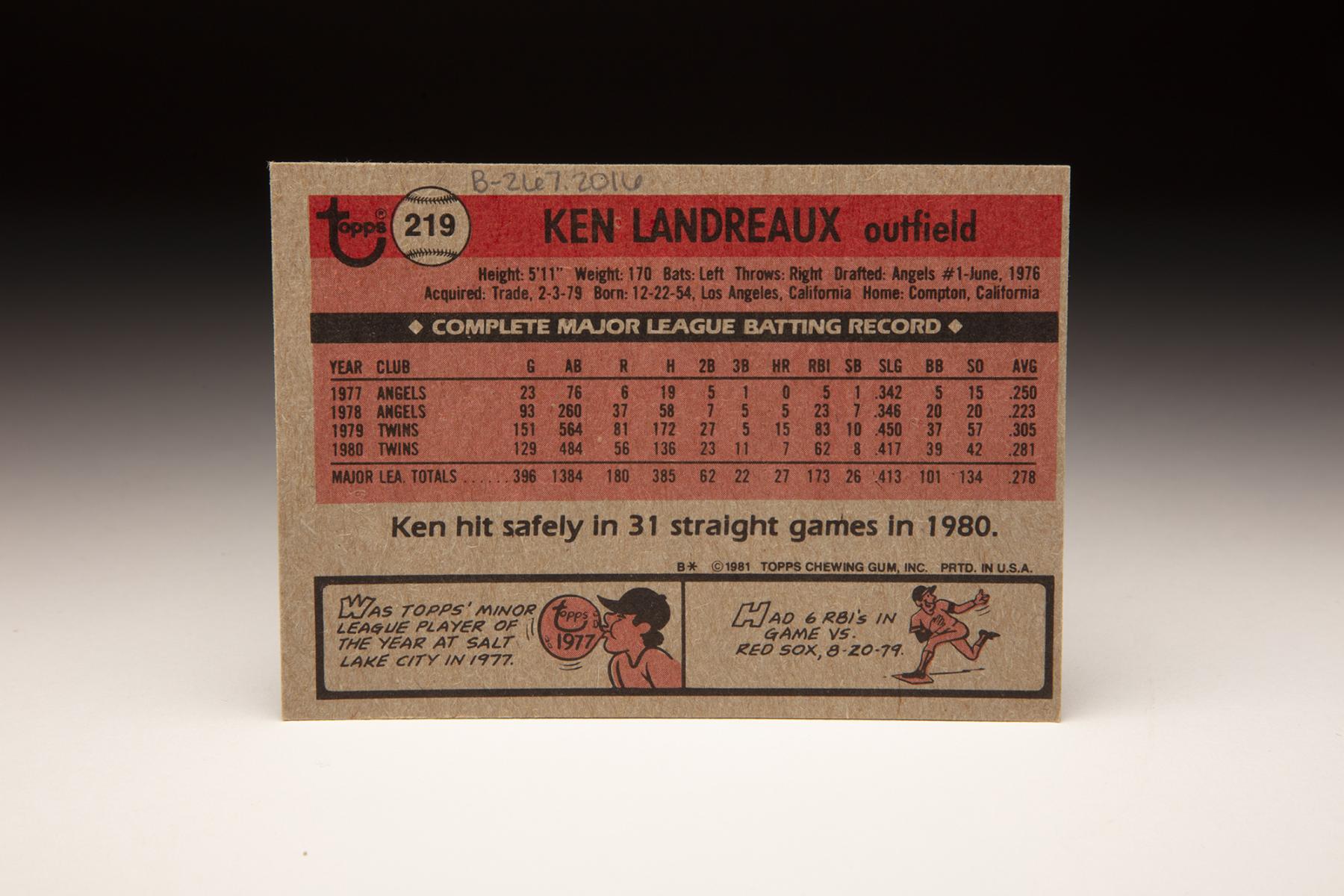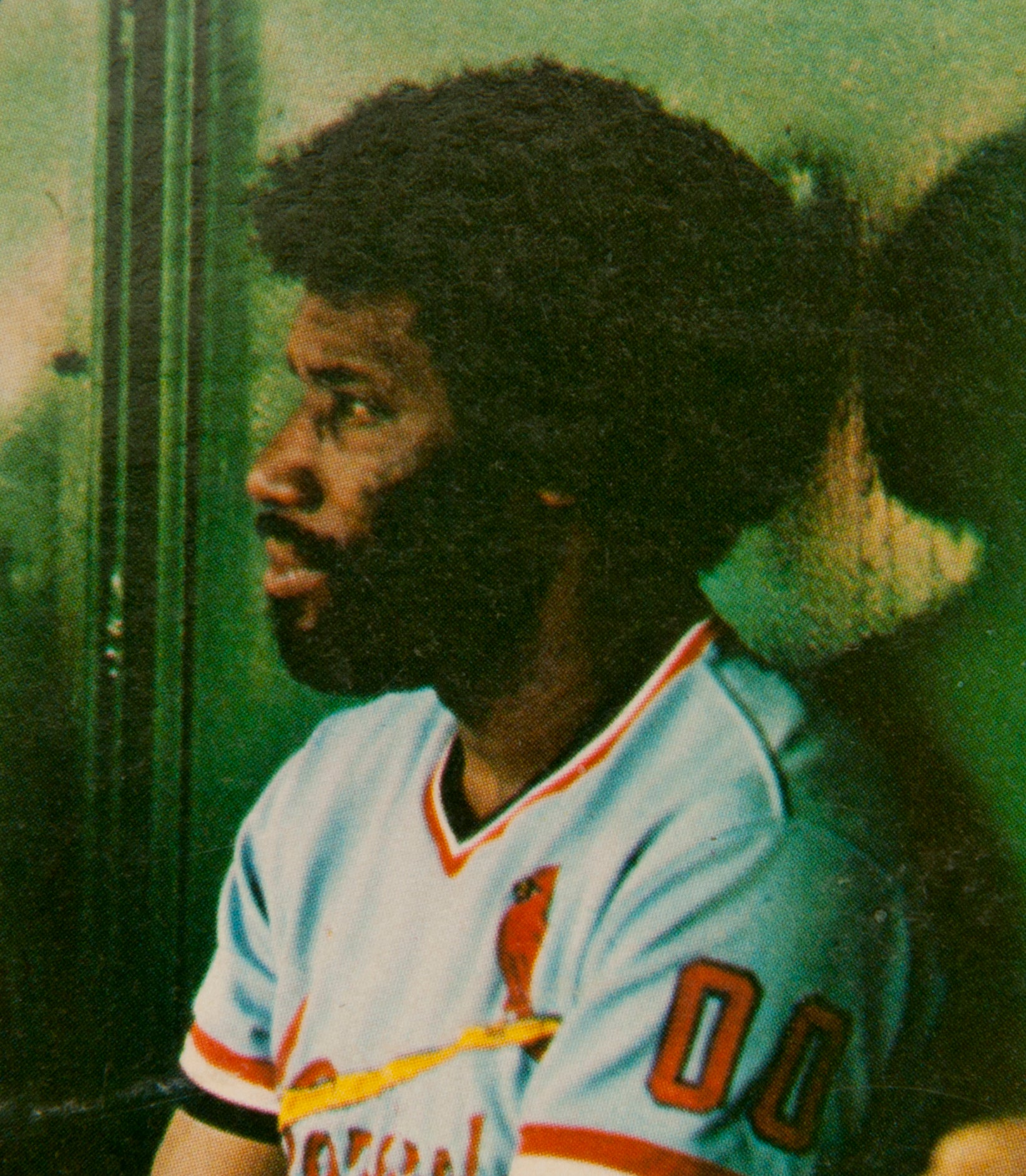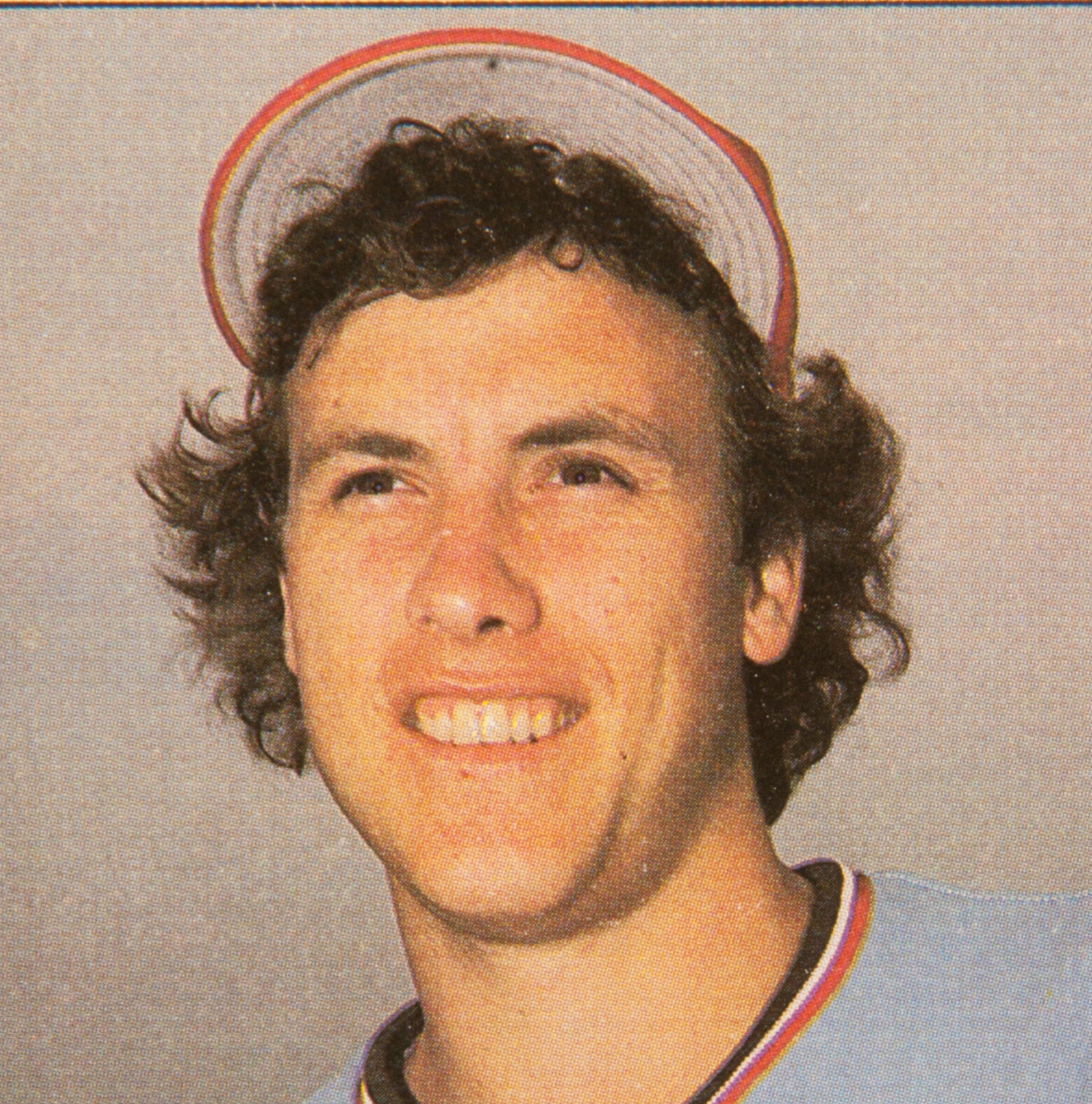- Home
- Our Stories
- #CardCorner: 1981 Topps Ken Landreaux
#CardCorner: 1981 Topps Ken Landreaux
In the spring of 1980 – when counting statistics still ruled the baseball world – Twins outfielder Ken Landreaux became the talk of the nation with a 31-game hitting streak.
It remains one of just 24 in-season streaks of that length or longer in the game’s history.
And it gave Landreaux his moment in the sun on the big league stage.
Hall of Fame Membership
There is no simpler, and more essential, way to demonstrate your support than to sign on as a Museum Member.
Born Dec. 22, 1954, Landreaux grew up in Compton, Calif., led Dominguez High School to a state title and was selected by the Astros in the eighth round of the 1973 MLB Draft. But he chose to enroll at Arizona State University, where he would star on the diamond along with other future big leaguers like Gary Allenson, Floyd Bannister, Bob Horner, Ken Phelps and Gary Rajsich.
The Sun Devils were ranked No. 1 in the country for much of 1976 before finishing third overall, and Landreaux led the way by topping all NCAA hitters with 87 RBI. The junior center fielder batted .413 while setting an NCAA record with 112 hits and did not commit an error in the field.
The Angels made Landreaux the No. 6 overall pick in that year’s draft and signed him to a contract that featured an $82,000 bonus. They sent him to Double-A El Paso, where he hit .220 in 21 games. But in 1977, the lefty-hitting Landreaux set the minor leagues on fire at El Paso and Triple-A Salt Lake City, batting a combined .357 with 27 home runs, 116 RBI and 20 stolen bases in 119 games. He was named the Minor League Player of the Year by Topps and earned a promotion to the big leagues, where he hit .250 in 23 games for the Angels.
In his big league debut on Sept. 11, Landreaux recorded three assists from center field.
“I can do better,” Landreaux told the Salt Lake Tribune just before being called up to the Angels. “I can’t afford to allow myself to let down. This biggest part of this game, I have discovered, is to keep yourself disciplined.”
Landreaux spent the 1978 season as the Angels’ fourth outfielder, appearing in 93 games and hitting .223. Then on Feb. 3, 1979, Landreaux was dealt to the Twins in a trade that also sent Dave Engle, Paul Hartzell and Brad Havens to Minnesota in exchange for future Hall of Famer Rod Carew.
“I realize I was in a trade with the best hitter in baseball,” Landreaux told the Orlando Sentinel during Spring Training of 1979. “I don’t feel pressure at all. I’m just going to play the game to be best of my ability – that should be enough or more than enough.”
It was. Landreaux hit .305 in 151 games in 1979, scoring 81 runs, recording 15 home runs and notching 83 RBI. He was regarded as one of the game’s top young players, and his 31-game hitting streak in 1980 did nothing to diminish that standing.
Landreaux’s hitting streak went from April 23 through May 30, with one game hitless game on May 7 when he entered the contest in the eighth inning as a pinch hitter – drawing a walk against the Orioles' Sammy Stewart but keeping his streak intact.
Landreaux hit .392 with 49 hits in those 32 games during his streak.
“We’ll start another one,” Landreaux told United Press International after going 0-for-4 against the Orioles on May 31, leaving his batting average at .348. “The important thing is that I did it once. Now I know I can do it and there is no reason I can’t do it again.”
However, a June slump – where Landreaux hit just .178 – dropped his average below .300.
And though he was named to the All-Star Game, Landreaux battled a hand injury and media criticism – for his sometimes controversial comments – down the stretch to finish at .281 with seven homers and 62 RBI in 129 games.
“You learn something new every year,” Landreaux told the Minneapolis Star. “This year, I learned turmoil.”
And more change was on the horizon. On March 30, 1981 – just 11 days before the start of the season – the Twins traded the 26-year-old Landreaux to the Dodgers in exchange for top prospect Mickey Hatcher and two minor leaguers.
“We wanted a left-handed batter,” Dodgers vice president Al Campanis told the Los Angeles Times.
“(At the Winter Meetings), they wanted Hatcher and Pete Guerrero. We said adios. A day ago they asked for just Guerrero and the minor leaguers. We said no. When they asked for Hatcher, we said we’d think about that.”
Landreaux was happy to return to Southern California.
“It’s like a dream come true: Dodger Blue,” Landreaux said. “I get a chance to play at home.”
Landreaux stepped in as the Dodgers’ every day center fielder and hit .251 with 18 stolen bases. He struggled in the first two rounds of the postseason, hitting .166 with one RBI and one run scored – but the Dodgers defeated the Astros and Expos to advance to the World Series against the Yankees.
Relegated to a bench role, Landreaux appeared in five games in the Fall Classic and only came to the plate six times. But his pinch-hit double in Game 4 produced a run when Davey Lopes singled him home in the third inning, cutting the Yankees’ lead to 4-1 in a game Los Angeles rallied to win 8-7.
Two games later, the Dodgers and Landreaux were world champions.
Landreaux remained the Dodgers center fielder for most of the next four seasons, helping Los Angeles win National League West titles in both 1983 and 1985. He never again approached his 1979 numbers, but maintained a reputation as a reliable defender and a base stealing threat – swiping 31 bags in 1983 and 30 in 1984.
In the 1985 National League Championship Series against the Cardinals, Landreaux hit .389 and doubled home what proved to be the winning run in Los Angeles’ 8-2 victory in Game 2. But this series – as well as the 1983 NLCS – ended in defeat for the Dodgers.
Landreaux moved into a reserve role in 1986 and 1987, hitting .203 in the latter year before his contract with the Dodgers expired. Finding no big league offers following the season, Landreaux signed with the Orioles and spent the year with Triple-A Rochester, hitting .272 in 64 games.
“I’m just keeping myself in shape,” Landreaux told the San Bernadino Sun. “But things don’t look too good.”
Landreaux signed with a Mexican League team to start the 1989 season but then returned to the Dodgers organization – the year after Los Angeles won the World Series. He was again, however, relegated to Triple-A.
He never played in the big leagues again.
“It’s like the blink of an eye,” Landreaux told the Albuquerque Tribune. “Swoosh – I was there (the big leagues). Then I wasn’t there. It’s hard to sit back and figure out how I fell out of where I was. You’re there and all of a sudden you’re not there. It’s real quick.”
Landreaux endured substance abuse issues after leaving the game, but got clean and eventually earned his degree from Arizona State University. His final big league totals include 1,099 hits, 91 home runs and 145 stolen bases over 11 seasons, including three postseason appearances and a World Series ring.
But for Ken Landreaux, his legacy will always be defined by the number 31 – and the magical spring of 1980.
Craig Muder is the director of communications for the National Baseball Hall of Fame and Museum
Related Stories

#CardCorner: 1981 Topps Tom Underwood

#CardCorner: 1981 Fleer Lynn McGlothen

#CardCorner: 1981 Topps Tom Underwood









